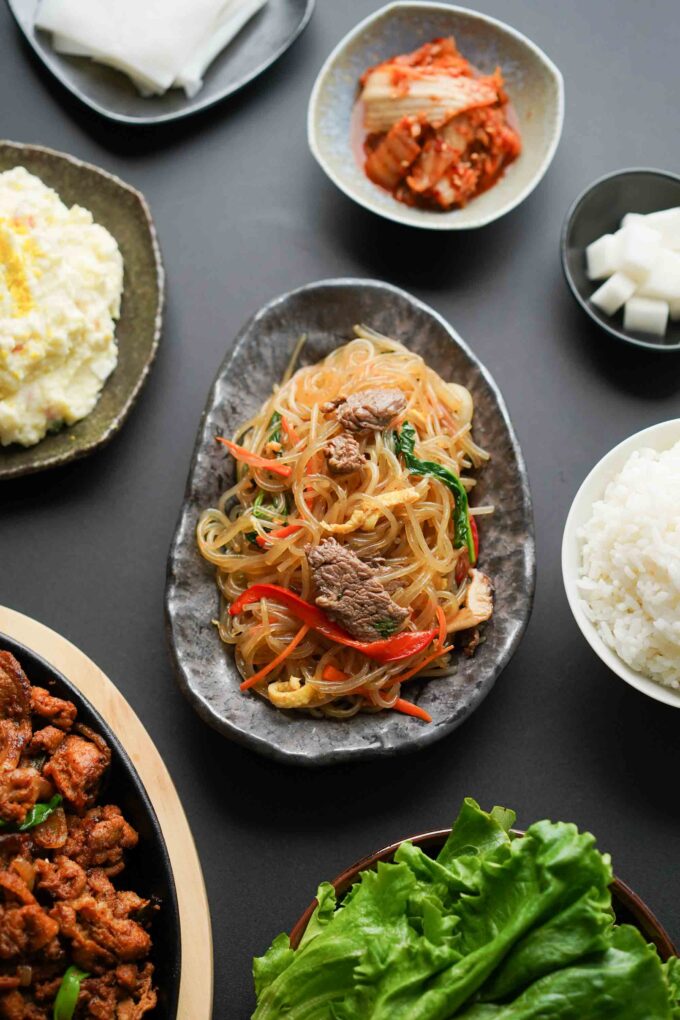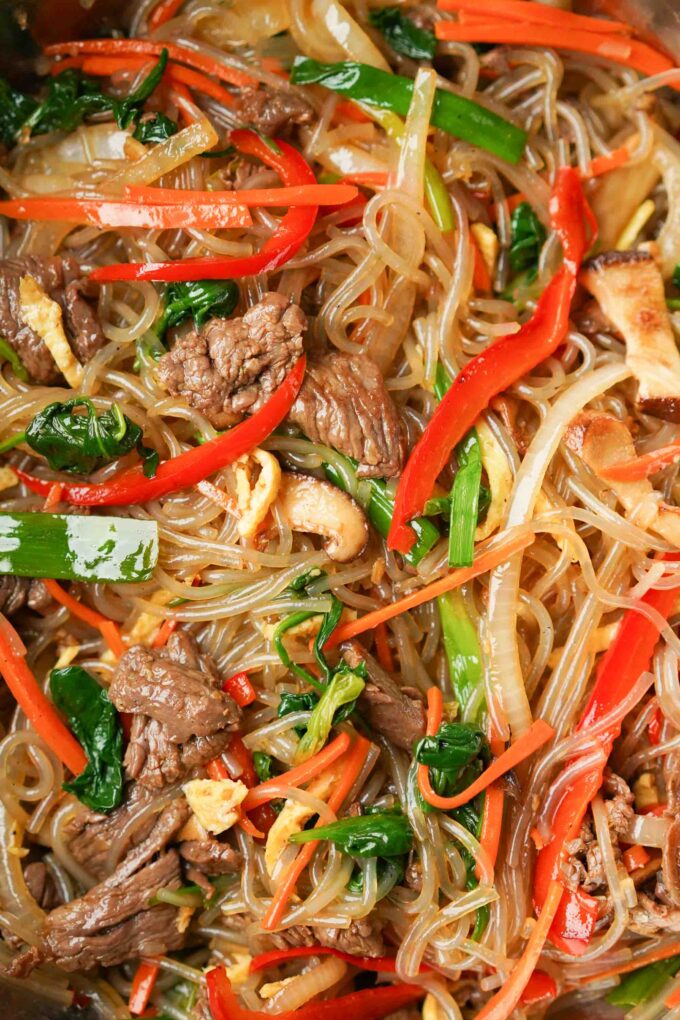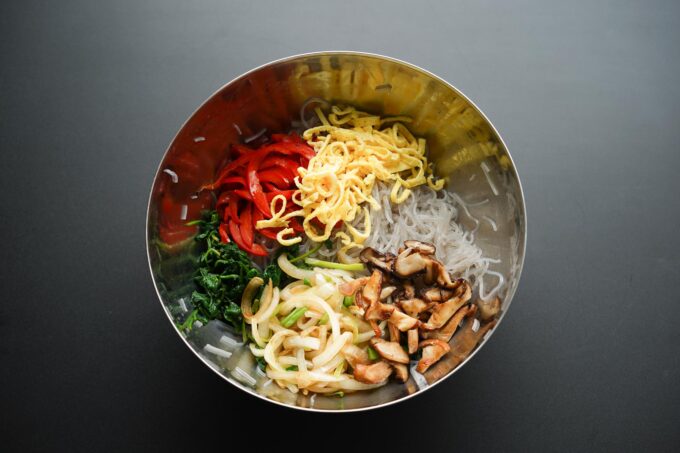Chewy and bouncy sweet potato glass noodles, tender and juicy ribeye pieces sprinkled with sweet carrots and bell peppers, earthy spinach and mushrooms, and flavorful onions–this japchae recipe is more than just a Korean side dish, it’s a full-on meal.

What is japchae?
Japchae is a type of Korean noodle recipe that is made with a special type of glass noodles. It’s a very popular banchan (or side dish) eaten at Korean restaurants and at home. My favorite restaurants to eat japchae are MoRanGak or Baekjeong.
The word “japchae” is translated to “mixed vegetable” in Korean and it’s a fairly basic dish. It’s typically made with a variety of ingredients like mushrooms, spinach, and carrots and seasoned with soy sauce and sesame oil.

Ingredients in japchae
Noodles

My favorite part about japchae is the clear noodles of course! These noodles are made of sweet potato and they turn translucent when they’re cooked. In Korean, they are called “dangmyeon,” which are specific cellophane or glass noodles that are made with sweet potato starch.
Glass noodles are also made with other ingredients like mung bean or purple sweet potatoes. The texture of Korean sweet potato noodles is best described as slightly chewy and bouncy. They don’t really have a particular flavor and stick to whatever seasoning you use on them.
To find the correct type of noodles at the store, try to look for these names that glass noodles also are labeled:
- sweet potato noodles
- yam noodles
- glass noodles
- cellophane noodles
- dangmyeon
- clear noodles
Vegetables

To make japchae, there are various vegetables you can add or substitute. It’s similar to yaki udon where you can add vegetables you prefer, but the main ingredients typically are carrots, onions, dried mushrooms (shiitake or wood ear), bell peppers, spinach, green onions, and garlic. You can also add cucumbers, chili peppers, or other ingredients too.
Meat / protein

You can also add protein into japchae, and my favorite to add is ribeye because it’s tender, fatty, and flavorful. Personally I love ribeye cap the BEST. Costco doesn’t always stock prime ribeye caps so when I saw it, I had to go with it for this recipe!
It’s around $20/lb so it’s not cheap–you can definitely go with less expensive cuts and still make delicious japchae. Since they’re sliced pretty thin, even skirt steak, or other lean cuts would work well too.
Alternatively, you can also choose to make this vegan by omitting the protein and just using vegetables–it’s just as tasty.
There is also an optional topping called jidan, which is an egg garnish made of egg yolk that’s beaten lightly, cooked on a pan like an omelet, and then cut into very thin strips. This is similar to the egg strips we add to Vietnamese bò bía, and bún thang.
Japchae sauce

Japchae sauce is a very simple and easy seasoning that includes soy sauce, sesame oil, black pepper, and dark brown sugar. It’s got a nice balance of saltiness from the soy sauce, nutty aromas from the sesame oil, and sweetness from the sugar.
How to make japchae

While making japchae is relatively easy, sometimes noodle dishes with lots of ingredients that have different cook times or processes can become quite confusing if you don’t keep an efficient timeline. This dish is similar to pancit canton or pancit palabok where you may need to cook things separately before mixing it all together at the end.
Here is the timeline I use for making japchae as efficient as I can without overcooking or undercooking ingredients while saving time:
- Combine the seasoning sauce ingredients.
- Marinate the meat.
- Blanch the spinach & season.
- Cook the noodles & season.
- Cook jidan (or egg topping).
- Saute the onions & green onion.
- Saute the mushrooms.
- Saute the carrots & bell peppers.
- Saute the garlic & meat.
- Combine all the ingredients in a large bowl with the seasoning & mix.
How to serve and store Korean glass noodles

Japchae is served either hot off the pan or cold from the fridge. I like it semi-chilled from the fridge when I eat it with my hot and steamy Korean BBQ at home or at the restaurant because it’s a nice balance. I love eating this with Korean potato salad, kalbi, Korean purple rice, and spicy pork bulgogi. If you have leftover noodles, you can store them in an airtight container and place them in the fridge.
These noodles will last for up to 4 days in the fridge. To reheat japchae, place it in a microwave-safe bowl and add a damp towel over it so it doesn’t dry out. I like to do 30-second intervals to heat it up.

Japchae Recipe (Korean Glass Noodles w/ Ribeye)
Ingredients
Seasoning
- 52 g (3 tbsp) soy sauce
- 12 g (1 tbsp) dark brown sugar
- 9 g (2 tsp) sesame oil
- .4 g (¼ tsp) black pepper
Meat
- 290 g (10 oz) sirloin or ribeye sliced thinly
- 30 g (2 tbsp) soy sauce
- 15 g (1 tbsp) garlic minced
- vegetable oil as needed
Spinach
- 60 g (2 c) spinach
- water for boiling & rinsing
- 2.8 g (½ tsp) soy sauce
- 1.2 g (¼ tsp) sesame oil
Noodles
- 225 g (8 oz) sweet potato glass noodles
- 9 g (2 tsp) sesame oil
Other vegetables & assembly
- 1 large egg
- 130 g (½ medium) yellow onion julienned
- 28 g (3 stalks) green onions sliced into 2-inch pieces
- 60 g (1 c) shiitake mushroom sliced thinly
- 50 g (1 medium) carrot julienned
- 72 g (¼ medium) red bell pepper julienned
- vegetable oil as needed
- salt as preferred
Equipment Used
- pot for boiling water
- Strainer
- scissors
- saute pan
- large mixing bowl
Instructions
Sauce & meat
- Combine all the seasoning ingredients until fully incorporated and set aside.
- In a small bowl, combine the beef and soy sauce. Mix until all the meat is fully coated in the soy sauce and set aside.
Spinach
- Boil a large pot of water over medium-high heat. Add the spinach and cook for about 1 minute or until the spinach wilts.
- Remove the spinach from the water and onto a strainer. (Do not discard the boiling water because you will need this to boil the noodles.) Place the spinach under running water until it’s cool to the touch. Turn off the faucet and use your hands to gently squeeze out the excess water from the spinach.
- Add the spinach into a small bowl and mix in the soy sauce and sesame oil. Set aside.
Noodles
- In the same pot of boiling water, add the sweet potato glass noodles and follow the packaging instructions. On my package of noodles, I boil them for 10 minutes and then remove them.
- Strain the noodles and add them into a large mixing bowl.
- Season them with the sesame oil. Mix until all the noodles are coated to prevent them from sticking.
- Use a pair of scissors to cut the noodles into manageable strips. I like to cut them into about 6 inch strips, but you can cut them how long you want them. This will make the noodles easier to handle and eat since they are so long.
Other vegetables & assembly
- Onions & green onions: In the same saute pan over medium heat, add a little oil if necessary and add the yellow onion. Cook for about 3 minutes or until the onions begin to soften, but not become translucent. Add the green onions and cook for an additional 2 minutes or until the green onions begin to wilt. Transfer the onions and green onions into the mixing bowl with the noodles.
- Carrots & red bell peppers: In the same saute pan, add a little oil if necessary and add the carrots and red bell peppers. Cook for about 2 minutes or until both carrots and bell peppers are softened to your liking. Transfer to the noodle bowl.
- Optional egg garnish (jidan): Crack the egg and separate the egg yolk and the egg white. Lightly beat the egg yolk. On a saute pan over medium heat, add a small amount of vegetable oil and add the beaten egg yolk. Cook until it becomes opaque and transfer to a cutting board. Roll up the omelette and cut it into very thin strips. Set aside.
- Mushrooms: In the same saute pan, add a little oil if necessary and add the mushrooms. Cook for about 3 minutes or until the mushrooms are softened and brown. Transfer to the noodle bowl.
- Garlic & meat: In the same saute pan, add a little oil if necessary and add the garlic. Cook for about 30 seconds or until it becomes fragrant. Add the marinated meat and cook for about 2 minutes or until the meat is browned and opaque. Transfer to the noodle bowl.
- Whisk the seasoning once more before adding it into the noodle bowl. Mix all the ingredients and the noodles in the bowl until everything is fully coated in the seasoning. Taste test the japchae and add more seasoning or salt if you prefer.
- You can chill it in the fridge before serving or eat immediately.




















Is there a way to get the measurements in pounds, teaspoon, tablespoon, and such and not in grams?
Hi Kieu! I already have this on the recipe next to each weight measurement in parantheses. If its not showing for you, can you tell me what device you’re using, the browser and version, operating system version, etc and I can look into it?
Hey, I just realized that the measurements are in tablespoon, etc. but when you go to print the recipe it disappeared.
Thanks for bringing this to my attention Kieu! I made a temporary change so the alternate measurements show, but I still need to style the recipe card so it’s more compact.